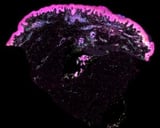Breakthrough Study Maps Prenatal Skin, Unlocks Secrets to Scarless Healing and Hair Growth
October 17, 2024
A groundbreaking study published in Nature reveals a comprehensive single-cell atlas of prenatal human skin, providing crucial insights into skin formation and disease mechanisms.
This research highlights the unique properties of human skin, the largest organ in the body, particularly its ability to heal without scarring before birth.
Researchers developed a functional miniaturized version of skin in the lab, capable of producing hair, which allows for the study of immune cells' roles in blood vessel formation.
The study identifies macrophages, a type of immune cell, as essential for promoting blood vessel growth and enhancing tissue vascularization in developing skin.
These immune cells are also critical for scarless healing, which could significantly influence approaches to wound care and surgical recovery.
The findings offer a molecular 'recipe' for building human skin and insights for creating new hair follicles, advancing regenerative medicine applications.
Co-first authors Dr. Elena Winheim and Dr. Hudaa Gopee emphasized the clinical potential of these discoveries for skin and hair transplants, particularly benefiting burn victims and those with scarring alopecia.
Professor Muzlifah Haniffa noted that the atlas and organoid model are valuable resources for studying congenital skin diseases and advancing regenerative medicine.
Conducted by the Wellcome Sanger Institute and Newcastle University, this research is part of the Human Cell Atlas initiative, which aims to map all cell types in the human body.
The study provides essential tools for further research in skin biology and regeneration, potentially leading to clinical applications that improve skin regeneration and prevent scarring.
Focusing on prenatal skin, which regenerates without scarring, offers insights into foundational skin growth stages and mechanisms.
This research contributes to the broader Human Cell Atlas project, enhancing our understanding of health and disease through detailed mapping of cell types.
Summary based on 3 sources
Get a daily email with more Science stories
Sources

ScienceDaily • Oct 16, 2024
Human skin map gives 'recipe' to build skin and could help prevent scarring
EurekAlert! • Oct 16, 2024
Human skin map gives 'recipe' to build skin and could help prevent scarring
Interesting Engineering • Oct 16, 2024
‘Recipe’ for scarless healing: Scientists make 1st-ever human skin map